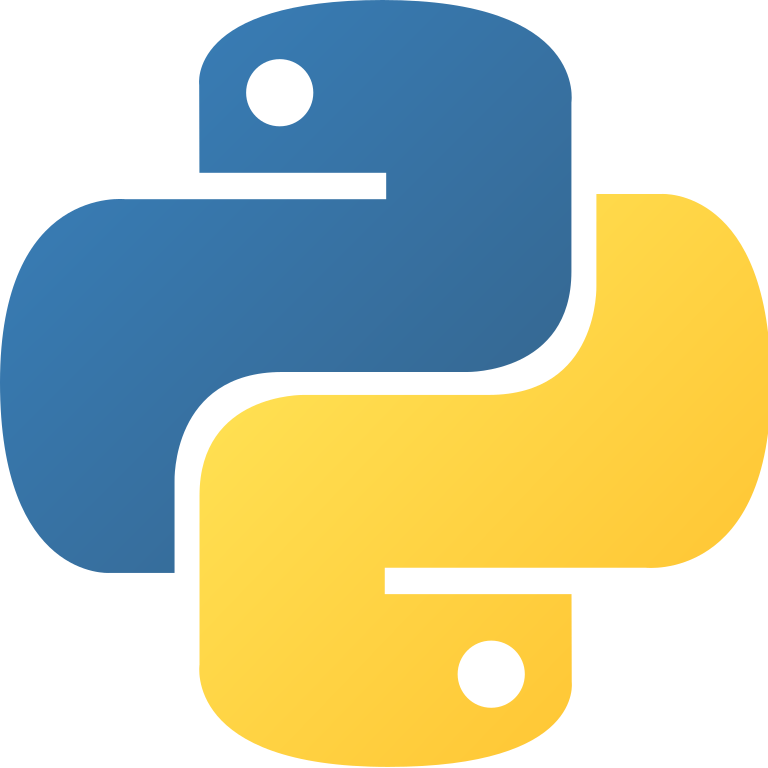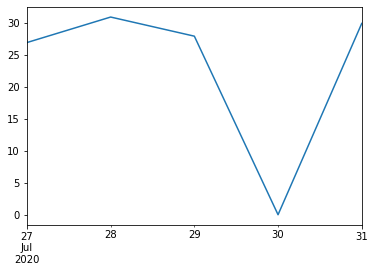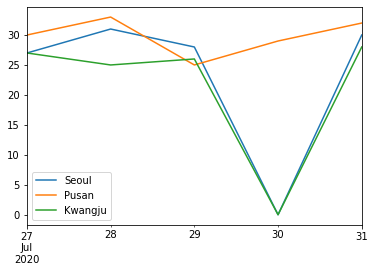BASEMENT
Python 7주차 - 2 본문

파이썬 실습
1. 리스트 중에서 i번째 숫자부터 j번째 숫자까지를 슬라이싱한 후 k번째에 있는 수를 찾아 출력
- 리스트 길이는 1이상 50이하
- 리스트의 각 원소 범위는 1이상 100이하
- 자르는 행위는 1이상 10이하
ex) [2,44,73,54,23,29,85,34] : 원본리스트
[[6,8,2], [4,8,5]] : commands
[34,85] : return값
import random
def nst_N(*args):
origin,s,e,k = args
result = sorted(origin[s-1:e])[k-1]
return result
# def nst_N(*args):
# origin, command = argsreturn list(map(lambda x:sorted(origin[x[0]-1:x[1]])[x[2]-1], command))
if __name__ == "__main__":
ary_n = random.randint(1,50)
origin = [random.randrange(1,100) for i in range(ary_n)]
commands = random.randint(1,10)
result = []
command = []
for i in range(commands):
ary_start = random.randint(1, ary_n)
ary_end = random.randint(ary_start, ary_n)
k = random.randint(1, ary_end-ary_start+1)
result.append(nst_N(origin, ary_start, ary_end, k))
command.append([ary_start, ary_end, k])
print(origin, command, result)
2. 주어진 문장에서 "encore" 또는 "엔코어" 찾기
- 문장은 input 함수로 입력
- 입력된 문장을 공백기준으로 분할 후 리스트에 저장
- 리스트에서 encore 또는 엔코어를 찾고, 위치값을 함께 반환
ex) enter a sentence >> I hope your skills improve through encore.
(['I', 'hope', 'your', 'skills', 'improve', 'through', 'encore'], [6])
def word_search(string):
splits = string.strip('.').split()
result = []
for index, word in enumerate(splits):
if word =='encore' or word =="엔코어":
result.append(index)
return splits, result
string = input("enter a sentence>> ")
print(word_search(string))
3. 콜라츠(Collatz) 추측
주어진 수가 1이 될때까지 다음 작업을 반복하여 모든 수를 1로 만들 수 있다는 추측
- 입력된 수가 짝수면 2로 나눔
- 입력된 수가 홀수면 3을 곱하고 1을 더함
- 결과로 나온 수에 같은 작업을 1이 될 때까지 반복
반복의 수가 500이 되도록 1이 되지 못하면 -1을 반환
ex) 6이 입력되면 , 6->3->10->5->16->8->4->2->1 로 8번 만에 1이 됨
def collatze(num):
count = 0
while True:
if num != 1:
if num%2 == 0:
num = num/2
count += 1
else:
num = num*3 + 1
count += 1
elif count == 500:
return -1
else:
return count
break
def collatz(num):
count = -1
for i in range(500):
if num == 1:
return i
if num%2 == 0:
num //= 2
else:
num = num*3 + 1
return count
if __name__ == "__main__":
n = int(input("enter positive integer >> "))
pdb.set_trace()
print(f'{n}은 {collatz(n)} 번만에 1이 됨')
num = int(input("enter positive integer >> "))
print(collatze(num))
# 재귀함수
def collatz(num):
global count
if num == 1:
return count
else:
count += 1
return collatz(num//2) if num%2 ==0 else collatz(num*3+1)
count = 0
num = int(input("enter positive integer >> "))
def collatz(num)
4. 연도를 입력하면 윤년인지 아닌지 판별
- 윤년 : 2월이 29일인 해
- 4로 나누었을때 나머지가 0이면서, 100으로 나누었을때 나머지가 0이 아닌 해
- 또는 400으로 나누었을때 나머지가 0인 해
def solution(year):
if (year%4 == 0 and year%100 != 0) or year%400 == 0 :
return print("윤년입니다")
else:
return print("평년입니다")
if __name__ == "__main__":
while True:
year = int(input("enter year >> "))
if year <= 0:
break
solution(year)
Pandas
1. Series
index와 value로 구성된 pandas의 기본 데이터
배열과 유사하나, 인덱스 조정이 가능하므로 검색 시 배열보다 편리함
import pandas as pd
import numpy as np
srs1 = pd.Series([10,20,30,40,50,60], dtype=float)
print(srs1[1])
print(srs1[0])
print(srs1[2], srs1[3])
print(srs1[[2,3]])
print(srs1.index, srs1.values)
srs1.astype(int) # 자료형 변경 srs1.astype(np.float32)
print()
# 결과
20.0
10.0
30.0 40.0
2 30.0
3 40.0
dtype: float64
RangeIndex(start=0, stop=6, step=1) [10. 20. 30. 40. 50. 60.]
Series에 index 부여 가능
Series와 index에 각각 name 부여 가능
srs2 = pd.Series([10,20,30,40,50,60], index = ['a','b','c','d','e','f'])
print(srs2['a'])
print(srs2['c'], srs2[2])
print(srs2[['a','c']])
# index값 없을 때 부여 가능
srs2.index = ['a','b','c','d','e','f']
# Series와 index에 name 부여
srs2.name = 'Points'
srs2.index.name = 'Person'
srs2
# 결과
10
30 30
a 10
c 30
dtype: int64
Person
a 10
b 20
c 30
d 40
e 50
f 60
Name: Points, dtype: int64
pandas 의 date_range 함수 -> 날짜 범위 데이터를 index로 사용 가능
+, -, *, / 연산의 결과는 Series 객체
dates = pd.date_range("2020-07-27", "2020-07-31")
temp1 = pd.Series([27,31,28,39,30], index=dates)
print(temp1)
print()
temp2 = pd.Series([30,33,25,29,32], index=dates)
temp_diff = temp2 - temp1
print(temp_diff)
print(temp_diff['2020-07-31'], temp_diff[4])
print()
# 기술적 통계함수 적용 가능
print(temp1.mean())
print(min(temp1))
# 결과
2020-07-27 27
2020-07-28 31
2020-07-29 28
2020-07-30 39
2020-07-31 30
Freq: D, dtype: int64
2020-07-27 3
2020-07-28 2
2020-07-29 -3
2020-07-30 -10
2020-07-31 2
Freq: D, dtype: int64
2 2
31.0
27
2차원 형태 리스트를 Series로
srs3 = pd.Series([[1,2,3,4], [5,6,7,8]])
print(srs3.index)
print(srs3.values)
print(srs3[0])
print(srs3[0][0])
print(srs3[[0,1]])
# 결과
RangeIndex(start=0, stop=2, step=1)
[list([1, 2, 3, 4]) list([5, 6, 7, 8])]
[1, 2, 3, 4]
1
0 [1, 2, 3, 4]
1 [5, 6, 7, 8]
dtype: object
2. DataFrame
하나 이상의 Series 객체를 갖는 인덱스 레이블 당 복수의 값을 가짐
컬럼 중심의 데이터 형식
관계형데이터베이스의 테이블과 유사함
srs3 = pd.DataFrame([[1,2,3,4], [5,6,7,8]])
print(srs3)
print(srs3[2])
print(srs3[2][0])
print(srs3[[1,3]])
# 결과
0 1 2 3
0 1 2 3 4
1 5 6 7 8
0 3
1 7
Name: 2, dtype: int64
3
1 3
0 2 4
1 6 8
1) columns, index 속성 부여
- column에 이름이 부여되면 기존의 컬럼이름을 사용할 수 없음
- 행의 이름인 index는 새롭게 부여되어도 인덱스 번호를 함께 사용할 수 있음
srs3 =pd.DataFrame([[1,2,3,4], [5,6,7,8]], columns = ['a','b','c','d'], index = ['aa', 'bb'])
print(srs3)
print(srs3['b'])
print()
print(srs3['b'][0])
print(srs3[['b','c']])
# columns, index 이름 변경 가능
srs3.index = ['cc','dd']
srs3.columns = ['one','two','three','four']
print(srs3)
# 결과
a b c d
aa 1 2 3 4
bb 5 6 7 8
aa 2
bb 6
Name: b, dtype: int64
2
b c
aa 2 3
bb 6 7
one two three four
cc 1 2 3 4
dd 5 6 7 8
2) Series를 DataFrame으로 적용하기
- name 속성이 필요함
- 딕셔너리형태로 name을 키 값으로 부여해주거나, 시리즈에 name 속성을 부여해 주어야 함
dates = pd.date_range('2020-07-27', '2020-07-31')
temp1 = pd.Series([27,31,28,29,30], index=dates)
temp2 = pd.Series([30,33,25,29,32], index=dates)
temp_df = pd.DataFrame({'Seoul':temp1, 'Pusan':temp2})
print(temp_df)
print(temp_df['Seoul'])
print(temp_df['Seoul']['2020-07-31'])
# 결과
Seoul Pusan
2020-07-27 27 30
2020-07-28 31 33
2020-07-29 28 25
2020-07-30 29 29
2020-07-31 30 32
2020-07-27 27
2020-07-28 31
2020-07-29 28
2020-07-30 29
2020-07-31 30
Freq: D, Name: Seoul, dtype: int64
30# temp_df2 = pd.DataFrame([temp1,temp2]) : 오류
temp1.name = 'Seoul'
temp2.name = 'Pusan'
temp_df2 = pd.DataFrame([temp1,temp2])
temp_df2
# 결과
2020-07-27 2020-07-28 2020-07-29 2020-07-30 2020-07-31
Seoul 27 31 28 29 30
Pusan 30 33 25 29 32
3) DataFrame의 행 단위 이용
- loc, iloc 사용
- loc : 인덱스 이름을 사용함
- iloc : 인덱스 번호를 사용함
temp_df2.loc['Seoul']
temp_df2.iloc[0]
# 결과
2020-07-27 27
2020-07-28 31
2020-07-29 28
2020-07-30 29
2020-07-31 30
Freq: D, Name: Seoul, dtype: int64from IPython.display import display # IPython shell 환경에서 dataframe을 table형식으로 보여줌
df = pd.DataFrame(np.array([[1,2,3], [10,20,30], [7,8,9]]), index = [1,'B',2], columns=['T','N','P'])
display(df)
print(df.iloc[1])
print(df.loc['B'])
# 결과
T N P
1 1 2 3
B 10 20 30
2 7 8 9
T 10
N 20
P 30
Name: B, dtype: int32
4) pd.concat
여러개의 배열을 합치는 함수
dates = pd.date_range('2020-07-27', '2020-07-31')
temp1 = pd.Series([27,31,28,0,30], index=dates)
temp2 = pd.Series([30,33,25,29,32], index=dates)
temp3 = pd.Series([27,25,26,0,28], index=dates, name='Kwangju')
temp4 = pd.Series([29,0,26,28,30], index=dates)
temp5 = pd.concat([temp1,temp2], axis=1, keys=['Seoul','Pusan'])
temp6 = pd.concat([temp5,temp3], axis=1)
print(temp6)
temp7 = temp5.append(temp3, ignore_index=True)
print(temp7)
# 결과
Seoul Pusan Kwangju
2020-07-27 27 30 27
2020-07-28 31 33 25
2020-07-29 28 25 26
2020-07-30 0 29 0
2020-07-31 30 32 28
Seoul Pusan 2020-07-27 00:00:00 2020-07-28 00:00:00 \
0 27.0 30.0 NaN NaN
1 31.0 33.0 NaN NaN
2 28.0 25.0 NaN NaN
3 0.0 29.0 NaN NaN
4 30.0 32.0 NaN NaN
5 NaN NaN 27.0 25.0
2020-07-29 00:00:00 2020-07-30 00:00:00 2020-07-31 00:00:00
0 NaN NaN NaN
1 NaN NaN NaN
2 NaN NaN NaN
3 NaN NaN NaN
4 NaN NaN NaN
5 26.0 0.0 28.0
5) join
- DataFrame을 합침
- merge 함수 사용
- on 속성 : 공통 속성의 컬럼을 적어줌
left = pd.DataFrame({'key':['foo','bar'], 'lval':[1,2]})
right = pd.DataFrame({'key':['foo','bar'], 'rval':[4,5]})
pd.merge(left, right, on='key')
left = pd.DataFrame({'key':['foo','foo'], 'lval':[1,2]})
right = pd.DataFrame({'key':['foo','foo'], 'rval':[4,5]})
left_right = pd.merge(left, right, on='key')
display(left_right)
# 결과
key lval rval
0 foo 1 4
1 bar 2 5
key lval rval
0 foo 1 4
1 foo 1 5
2 foo 2 4
3 foo 2 5
6) 컬럼 추가
- loc 사용 또는 dataframe이름['새로운 컬럼 이름]
df = pd.DataFrame(np.array([[1,2,3], [10,20,30], [7,8,9]]), index=[1,'B',2], columns=['T','N','P'])
display(df)
# loc 사용
df.loc[:, 'Y'] = pd.Series([100,200,300], index=df.index)
display(df)
# dataframe이름['새로운컬럼이름']
df['M'] = pd.Series([11,12,13], index=df.index)
display(df)
# 결과
T N P
1 1 2 3
B 10 20 30
2 7 8 9
T N P Y
1 1 2 3 100
B 10 20 30 200
2 7 8 9 300
T N P Y M
1 1 2 3 100 11
B 10 20 30 200 12
2 7 8 9 300 13
7) 컬럼 삭제
- drop 함수 사용
- inplace = True : 변화 내용을 원본에 반영함
a = df.drop('T', axis=1, inplace=False)
display(df)
display(a)
df.drop('T', axis=1, inplace=True)
display(df)
# 결과
T N P Y M
1 1 2 3 100 11
B 10 20 30 200 12
2 7 8 9 300 13
N P Y M
1 2 3 100 11
B 20 30 200 12
2 8 9 300 13
N P Y M
1 2 3 100 11
B 20 30 200 12
2 8 9 300 13
8) row 삭제
- index와 drop 명령어 사용
print(df.index[1])
df.drop(df.index[1], inplace=True)
print(df)
print(df.drop(1))
display(df)
# 결과
B
N P Y M
1 2 3 100 11
2 8 9 300 13
N P Y M
2 8 9 300 13
N P Y M
1 2 3 100 11
2 8 9 300 13
9) 데이터 수정
df.iloc[0,0] = 1000
display(df)
df.loc[1,'N'] = 2000
display(df)
x = pd.DataFrame({'x':[1,2,3], 'y':[3,4,5]})
x.iloc[1] = {'x':9, 'y':99}
x
# 결과
N P Y M
1 1000 3 100 11
2 8 9 300 13
N P Y M
1 2000 3 100 11
2 8 9 300 13
x y
0 1 3
1 9 99
2 3 5
10) DataFrame 복합읽기
import matplotlib.pyplot as plt
temp6.loc['2020-07-27':'2020-07-29','Seoul':'Pusan']
temp6.loc[temp6['Seoul']>30,:]
temp6.loc[temp6['Seoul']>30, 'Seoul':'Seoul']
temp6.loc[temp6['Pusan']>30]
temp6[temp6['Pusan']>30]
print(temp6.Pusan[0:3])
print(temp6.Pusan[temp6.Pusan>30])
print(temp6[temp6.Seoul>30])
print(temp6.Pusan['2020-07-27':'2020-07-29'])
print(temp6.iloc[[1,3]].Seoul)
print(temp6.Kwangju>27)
temp6.Seoul.plot()
temp6.plot()
plt.show()
# 결과
2020-07-27 30
2020-07-28 33
2020-07-29 25
Freq: D, Name: Pusan, dtype: int64
2020-07-28 33
2020-07-31 32
Name: Pusan, dtype: int64
Seoul Pusan Kwangju
2020-07-28 31 33 25
2020-07-27 30
2020-07-28 33
2020-07-29 25
Freq: D, Name: Pusan, dtype: int64
2020-07-28 31
2020-07-30 0
Freq: 2D, Name: Seoul, dtype: int64
2020-07-27 False
2020-07-28 False
2020-07-29 False
2020-07-30 False
2020-07-31 True
Freq: D, Name: Kwangju, dtype: bool

'Programming > Python' 카테고리의 다른 글
| Python 8주차 - 2 (0) | 2020.08.10 |
|---|---|
| Python 8주차 - 1 (0) | 2020.08.05 |
| Python 7주차 - 1 (0) | 2020.07.29 |
| Python 6주차 - 2 (0) | 2020.07.26 |
| Python 6주차 - 1 (0) | 2020.07.26 |




